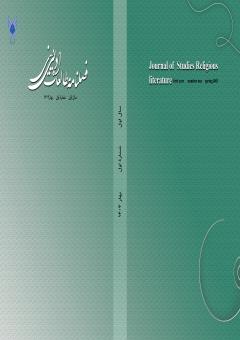Examining the elements of coherence of the text of Surah Qalam based on the theory of Michael Halliday and Ruqieh Hassan
Subject Areas : Main Subject
alireza gojezadeh
1
,
fatemeh niroee aghmiuni
2
![]() ,
maryam bahramyan
3
,
maryam bahramyan
3
1 - Islamic Azad University
2 - Islamic Azad university
3 - Islamic Azad University
Keywords: Surah Qalam, text coherence, Halliday, Hassan,
Abstract :
Coherence is one of the important and fundamental elements of communication in the text. Halliday's theory is the degree of coherence based on the semantic relationships between sentences and the determination of coherence factors in different parts of the text and has given continuity to it. So that the reader or listener can find out the missing elements in the text, which are necessary for its interpretation. There are connections between the verses with some other verses, which must be in the form of one word and have harmonious meanings and a regular structure. Coherence in the text occurs when the interpretation and interpretation of one element is dependent on the interpretation and interpretation of another element and the internal elements of a text and its sentences are interrelated in many ways. There are various theories, the most complete of which in terms of classification is the theory of Michael Halliday and Ruqiyeh Hassan (1976). The theorists divide text coherence into three types: structural, lexical, and semantic-linkage, and introduce factors and elements for each. The result of this research is the examination of the coherence of the text in Surah Qalam, which all its structures and types are mentioned in this Surah, which are: grammatical (reference, substitution and deletion), lexical (repetition, symmetry), and semantic connection (simile connection). , the relationship against expectation is a causal relationship). Also, the most elements of coherence in this surah are related to the structure of semantic connection (additive-metaphorical), (causal-causal connection) and temporal connection.
1. قرآن کریم.
2. آقایی، سیدعلی. (1386). «انسجام ساختاری در قرآن پژوهشی درباره رهیافت اصلاحی در تفسیر قرآن»، کتاب خردنامه.
3. جلالی، جلال الدین.(1388). «ضرورت شناخت و کاربرد انسجام و پیوستگی در ترجمه انگلیسی قرآن. ترجمان. شماره 25.
4. جمشیدی، محمدحسین.(1390). «عمليات رواني در صدر اسلام، عمليات رواني مشركان عليه پيامبر(ص) و قرآن»، پایگاه اطلاع رسانی سراج اندیشه.
5. حمودة، طاهر سلیمان. (1999). ظاهرة الحذف في الدرس اللغوي. الإسکندرية: الدار الجامعیة للطباعة و النشر و التوزیع.
6. دهقانی، ناهید. (1388). «بررسی عناصر ایجاد انسجام متن در کشف المحجوب هجویری»، دو فصلنامه آیینه میراث، شماره 45.
7. کریمی¬نیا، مرتضی. (1376). «از مقتضیات زبان فارسی در ترجمه قرآن کریم»، فصلنامهي حوزه و دانشگاه، سال سوم، شماره 10.
8. طباطبایی، سید محمد حسین. (1383). المیزان فی تفسیر القرآن، دفتر انتشارات اسلامی جامعة مدرسین حوزة علمیه قم.
9. العوا، سلوی. (1387). «تناسب مضمونی و انسجام ساختاری در قرآن»، ناقد سید علی آقایی، کتاب ماه دین، شماره 132.
10. غلامحسین¬زاده، غلامحسین و حامد نوروزی. (1387). « نقش ارجاع شخصی و اشاره¬ای در انسجام شعر عروضی فارسی»، فصلنامه پژوهشهای ادبی، سال 5، شماره 19.
11. لطفی¬¬پور ساعدی، کاظم.(1371). « در آمدی بر سخن¬کاوی»، تهران: مجله زبانشناسی، سال نهم، ش1.
12. ــــــــــــــــــــــ . (1374). درآمدی به اصول و روش ترجمه، تهران: مرکز نشر دانشگاهی
13. محمودی، شعیب.(2010). بنیة النص في سورة الکهف: مقاربة نصیة للإتساق و السیاق، تحت إشراف الأستاذ الدکتور یحی بعیطیش، الجزایر: جامعة منتوری.
14. معین الدینی، فاطمه.(1382).« شگردهای ایجاد انسجام متن در کلیله و دمنه»، مجله فرهنگ، شماره 46 و 47.
15. محمد ابراهیمی، زینب.( 1375- 76). روابط انسجامی در زبان فارسی(ارجاع)، پایانامه کارشناسی ارشد، دانشگاه تهران.
16. Halliday, M.A.K. and Ruqaiya Hassan .(1976). Cohesion in English, London: Longman.
17. Widdowson, H.G .(1978). Teaching Languge as Communication. Oxford: O.Up.
18. Larson, M.L .(1984). Meaning-based Translation. New York, University Press of America.

